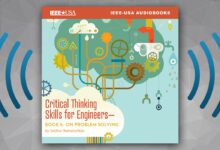
Walt Disney, that most iconic of creative and visionary entrepreneurs, famously said, “If you can dream it, you can do it.”
Now, two engineers who have devoted the past few years to doing just that-as Disney Imagineers-are sharing their passion for innovation, and they’re encouraging others who want to dream big. IEEE Members Jonathan Chew and Leo Szeto have written a two-part e-book that offers individuals working in any discipline with valuable insights on how to lead change. The new e-book expands on their presentation at the 2016 IEEE-USA Future Leaders Forum, and a subsequent webinar.
In Secrets to Being a World-Changer-Part 1: The Being of Leadership, they outline how to establish the mindset for being a world-changer. Part 2, The “Doing” of Leadership, deals with actually performing world-changing actions, and is scheduled for publication in June.
Chew and Szeto speak from practical, on-the-job experience. Imagineers in the research and development arm of The Walt Disney Company are free from the normal business constraints that can stifle creativity. All Disney Imagineers-whether they’re illustrators, architects, or engineers-among other professionals with that designation-are encouraged to indulge in “blue sky speculation,” where no limitations exist. Both men worked for several years on Imagineering’s design and building for Shanghai Disneyland, which opened in 2016.
For their e-book, the authors begin with a premise based on Ikigai, the Japanese concept that essentially means “a reason to get up in the morning.” They explain that according to the Japanese definition, Ikigai fuses together four related concepts: what you’re good at, what you’re willing to do, what you’re paid for, and what you want to do. At the heart of the four concepts, say Chew and Szeto, is your purpose in life.
Drawing inspiration from this, they have created what they call The Circles of VICtory-three overlapping circles that describe the basic ingredients all great leaders share in abundance:
Vision: Something to be passionate about, combined with one’s beliefs
Imagination: The ability to see the world from different perspectives
Creativity:Methodologies to generate novel solutions to problems
“Wherever you are in your life’s journey,” they write, “you can begin at any point in the Circles of VICtory, and start working on the parts and pieces that need improving.”
At the heart of this volume are the authors’ in-depth discussions of how anyone aspiring to be a world-changer can develop an action plan based on Vision, Imagination and Creativity.
For example, they believe that by sharpening one’s vision, it’s possible to become a better leader. “Observe the issues in your organization,” they write. “What are some of the problems that persist? How many people are affected? Who else, if anyone, is trying to solve this problem? Are you passionate enough about the issue to do something about it?”
They recommend careful study to create beliefs. Such research can include talking to others to better understand the problem, or possibly experiencing the problem for yourself. Chew and Szeto then suggest following up your investigation by strategizing how to implement the solution, taking in who would be affected both positively and negatively, and what could be done to minimize or mitigate the negatives. Finally, they advise communicating the message clearly and concisely, so others can understand and support the value of any change.
In discussing the second leadership quality, Imagination, Chew and Szeto point to a story about the legendary Walt Disney. When he was seen crouching down as he roamed the area that became the first Disneyland in California, Disney explained that this stance enabled him to see from a child’s perspective. It was valuable insight into realizing his vision for a child-friendly theme park.
The authors also demonstrate-with a visual game that their readers can play-that when trying to solve a problem, a different visual perspective can also provide the solution.
For Creativity, the third leadership quality, the pair offers their own definition: The process in which new and valuable ideas are formed. One of the idea-generating tools they recommend is CAMPERS, the acronym for a set of seven concepts that can loosen creative blocks and get ideas to start flowing:
Combine.
What would happen if this product was combined with another to create something new?
Adapt.
How can you adapt or adjust this product to serve another purpose? Or, can you re-purpose a solution to another problem, and mold it to the current situation?
Modify/Magnify.
How can you enlarge or change the shape, look, or feel of your product?
Put to Other Uses.
Could you use this product elsewhere, perhaps in another industry?
Eliminate.
How can you streamline or simplify the product?
Rearrange/Reverse.
What would happen by changing the order, reversing the process, or sequencing things differently?
Substitute.
What materials or resources can be substituted or swapped to improve the product?
Adding a dose of real-world thinking, Chew and Szeto provide a theoretical example of using CAMPERS, to develop what is now a Disneyland ride known as The Indiana Jones Adventure: Temple of the Forbidden Eye. The authors apply each of the seven CAMPERS concepts to imagining creative discussions that might have taken place, if someone was using this idea-generating tool.
Jonathan Chew joined Walt Disney Imagineering in 2011, in Glendale, Calif., and is currently a program manager overseeing much of the Inspirational Blue Sky projects for potential immersive experiences. He has a B.S. in electrical engineering from the University of California, Los Angeles (UCLA), and was president of the IEEE Student Branch.
Leo Szeto founded and now heads Codeate, which develops immersive experiences using new software technologies in virtual and augmented reality. Previously, he was with Walt Disney Imagineering for four years, and he worked mostly as a ride controls software engineer. Szeto has a B.S. in electrical engineering and computer engineering from UCLA.
Secrets to Being a World-Changer–Part 1: The Being of Leadership, is now available from the IEEE-USA Shop. The book is $2.99 for IEEE members and $4.99 for non-members.






